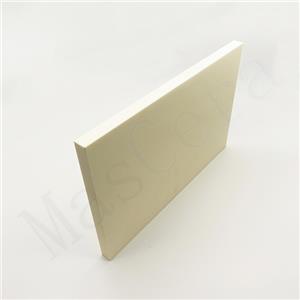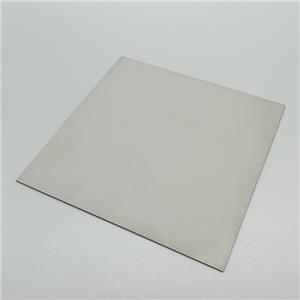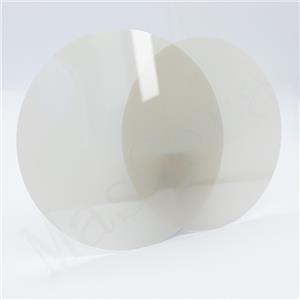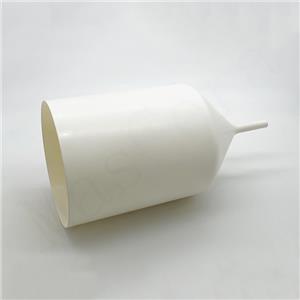Carbon Reaction of Si₃N₄ Ceramic in High-Temperature Environments
In high-temperature industrial applications, silicon nitride (Si₃N₄) ceramic is widely used for its excellent heat resistance, oxidation resistance, and mechanical strength. However, recent studies indicate that under extreme high temperatures (≥1300°C), Si₃N₄ may react with carbon, gradually transforming into silicon carbide (SiC) ceramic while releasing nitrogen gas (N₂). This finding is crucial for industries that rely on Si₃N₄ in high-temperature and carbon-rich environments.
Reaction Mechanism of Si₃N₄ and Carbon
Research shows that at temperatures above 1300°C, Si₃N₄ may undergo the following chemical reaction:
Si3N4+3C→3SiC+2N2↑
During this process, the surface of Si₃N₄ gradually converts into SiC, accompanied by the release of nitrogen gas. Several factors influence this reaction, including temperature, environmental composition, and the form of carbon. Free carbon sources (such as carbon powder) or carbon-containing gases (e.g., CH₄, C₂H₂) accelerate the transformation process.
Stability of Si₃N₄ Ceramic in Different Environments
The stability of Si₃N₄ ceramic varies depending on its working conditions:
Environment | Reaction with Carbon? | Explanation |
Nitrogen (1100°C, 6 bar) | Extremely difficult | Excess nitrogen stabilizes Si₃N₄, minimizing carbon impact. |
Vacuum (10⁻² mbar, 1000°C) | Relatively stable | Si₃N₄ may slightly decompose under low pressure, but the reaction rate is low. |
High-temperature carbon atmosphere (e.g., CH₄, C₂H₂, CO, carbon powder) | Likely | At ≥1300°C, Si₃N₄ readily converts to SiC, affecting long-term material performance. |
Comparison with Other High-Temperature Materials
For applications in carbon-rich environments, selecting the right material is critical. Below is a comparison of Si₃N₄ ceramic with other common high-temperature materials:
Material | Reaction with Carbon at High Temperatures | Remarks |
Si₃N₄ Ceramic | May react at ≥1300°C | Stable at 1000-1100°C, but may partially convert to SiC in long-term high-temperature carbon environments. |
SiC Ceramic | No reaction | Naturally a carbide, making it highly resistant to carbon infiltration. |
Al₂O₃ Ceramic | May undergo carbon reduction | At ≥1500°C, carbon may reduce Al₂O₃ to Al or AlN. |
Molybdenum (Mo) / Tungsten (W) | Prone to carburization | At ≥1000°C, these metals absorb carbon, leading to embrittlement. |
Recommendations: How to Minimize Carbon's Effect on Si₃N₄
For applications below 1100°C or in nitrogen-rich environments, Si₃N₄ remains a reliable high-temperature material. However, for operations in carbon-rich atmospheres (e.g., carburizing furnaces, carbon reaction furnaces) at ≥1300°C, consider the following strategies:
Use SiC Ceramic Instead of Si₃N₄
SiC ceramic is inherently resistant to carburization, making it a superior choice for high-temperature carbon environments.
Apply Protective Coatings
Coating Si₃N₄ surfaces with SiO₂ (silicon oxide) or BN (boron nitride) can effectively reduce carbon diffusion, extending the material's lifespan.
Optimize Process Parameters
When using Si₃N₄ in nitrogen-rich environments, maintain temperatures below 1200°C to minimize potential carbon reactions.
Si₃N₄ ceramic remains stable in 1100°C nitrogen-rich or 1000°C vacuum environments, but its resistance to carbon infiltration weakens above 1300°C, gradually transforming into SiC. For extreme high-temperature applications, SiC ceramic is recommended, or protective coatings can be used to enhance Si₃N₄’s durability.
With ongoing advancements in high-temperature materials research, Si₃N₄ continues to be a promising material in industrial applications. Future developments in surface modification and composite ceramics will further enhance Si₃N₄’s resistance to extreme conditions, ensuring its reliability and longevity in high-temperature industries.
XIAMEN MASCERA TECHNOLOGY CO., LTD. is a reputable and reliable supplier specializing in manufacturing and sales of technical ceramic parts. We provide custom production and high precision machining for a wide series of high performance ceramic materials including alumina ceramic, zirconia ceramic, silicon nitride, boron nitride , aluminum nitride and machinable glass ceramic. Currently, our ceramic parts can be found in many industries like mechanical, chemical, medical, semiconductor, vehicle, electronic, metallurgy etc. Our mission is to provide the best quality ceramic parts for global users and it is a big pleasure to see our ceramic parts work efficiently in customers' specific applications. We can cooperate on both prototype and mass production, welcome to contact us if you have demands.




